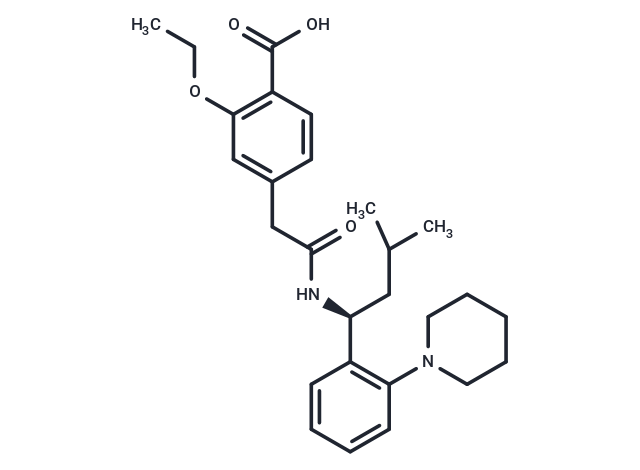Shopping Cart
Remove All Your shopping cart is currently empty
Your shopping cart is currently empty
Repaglinide (AG-EE 623ZW) is a benzoic acid derivative that stimulates insulin secretion from the pancreas and is used in the therapy of type 2 diabetes. Repaglinide has been linked to rare instances of clinically apparent acute liver injury.

| Pack Size | Price | USA Warehouse | Global Warehouse | Quantity |
|---|---|---|---|---|
| 10 mg | $30 | In Stock | In Stock | |
| 25 mg | $43 | In Stock | In Stock | |
| 50 mg | $54 | In Stock | In Stock | |
| 100 mg | $79 | In Stock | In Stock | |
| 500 mg | $167 | In Stock | In Stock | |
| 1 mL x 10 mM (in DMSO) | $54 | In Stock | In Stock |
| Description | Repaglinide (AG-EE 623ZW) is a benzoic acid derivative that stimulates insulin secretion from the pancreas and is used in the therapy of type 2 diabetes. Repaglinide has been linked to rare instances of clinically apparent acute liver injury. |
| In vitro | Repaglinide binds to NCS proteins in a calcium-dependent manner, but does not bind to CAM or S100 proteins.Repaglinide tightly binds to CCaMK and PpCaMK in a calcium-dependent manner, antagonizing the regulatory function of the structural domains, with IC 50 values of 55 mM and 4 mM for the CCaMK and PpCaMK domains.Repaglinide binds to CCaMK and PpCaMK domains with low affinity (K(D) = 59 nM) to bind SUR1 alone, but binds SUR1 with high affinity to co-express with Kir6.2, increasing it approximately 150-fold.Repaglinide antagonizes the inhibitory effect of restoring protein in the retinal kinase assay, with an IC50 value of 400 mM.Repaglinide also antagonizes the inhibitory effect of restoring protein in the retinal kinase assay, with an IC50 value of 400 mM. |
| In vivo | Repaglinide binds to NCS proteins in a calcium-dependent manner, but does not bind to CAM or S100 proteins.Repaglinide tightly binds to CCaMK and PpCaMK in a calcium-dependent manner, antagonizing the regulatory function of the structural domains, with IC 50 values of 55 mM and 4 mM for the CCaMK and PpCaMK domains.Repaglinide binds to CCaMK and PpCaMK domains with low affinity (K(D) = 59 nM) to bind SUR1 alone, but binds SUR1 with high affinity to co-express with Kir6.2, increasing it approximately 150-fold.Repaglinide antagonizes the inhibitory effect of restoring protein in the retinal kinase assay, with an IC50 value of 400 mM.Repaglinide also antagonizes the inhibitory effect of restoring protein in the retinal kinase assay, with an IC50 value of 400 mM. |
| Synonyms | AG-EE 623ZW, AG-EE 388 ZW |
| Molecular Weight | 452.59 |
| Formula | C27H36N2O4 |
| Cas No. | 135062-02-1 |
| Smiles | [C@H](NC(CC1=CC(OCC)=C(C(O)=O)C=C1)=O)(CC(C)C)C2=C(C=CC=C2)N3CCCCC3 |
| Relative Density. | 1.137g/cm3 |
| Storage | Powder: -20°C for 3 years | In solvent: -80°C for 1 year | Shipping with blue ice/Shipping at ambient temperature. | |||||||||||||||||||||||||||||||||||
| Solubility Information | Ethanol: 84 mg/mL (185.6 mM), Sonication is recommended. DMSO: 55 mg/mL (121.52 mM), Sonication is recommended. H2O: < 1 mg/mL (insoluble or slightly soluble) | |||||||||||||||||||||||||||||||||||
| In Vivo Formulation | 10% DMSO+40% PEG300+5% Tween 80+45% Saline: 2 mg/mL (4.42 mM), Sonication is recommended. Please add the solvents sequentially, clarifying the solution as much as possible before adding the next one. Dissolve by heating and/or sonication if necessary. Working solution is recommended to be prepared and used immediately. The formulation provided above is for reference purposes only. In vivo formulations may vary and should be modified based on specific experimental conditions. | |||||||||||||||||||||||||||||||||||
Solution Preparation Table | ||||||||||||||||||||||||||||||||||||
DMSO/Ethanol
| ||||||||||||||||||||||||||||||||||||
| Size | Quantity | Unit Price | Amount | Operation |
|---|

Copyright © 2015-2025 TargetMol Chemicals Inc. All Rights Reserved.